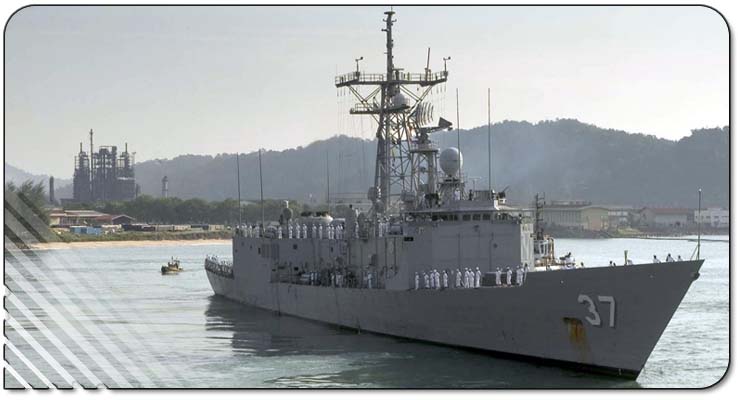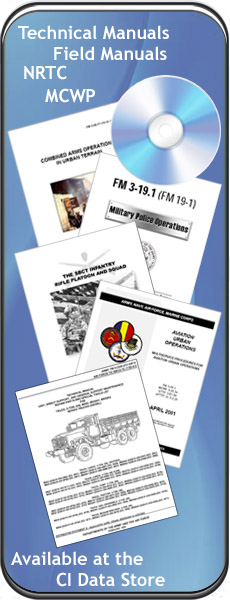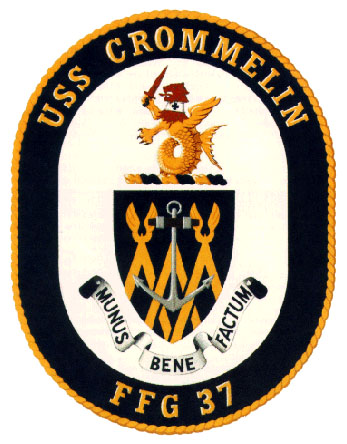FFG 37 | USS CROMMELIN

Namesake:Not yet available |
||||||||||||||||||||||
Historical Notes:USS CROMMELIN's keel was laid on 30 May 1980 at Todd Pacific Shipyard, Seattle Division. The frigate was christened and launched on 2 July 1981. Commissioned on 18 June 1983, CROMMELIN was assigned to Destroyer Squadron 9 and reached its homeport of Long Beach, California in August 1983. In 1985, CROMMELIN was assigned to the USS CONSTELLATION battle group and deployed to the western Pacific and Indian Oceans. During this deployment, CROMMELIN became the first FFG to successfully engage a high-speed, maneuvering target with missiles. It was also the first ship to complete an operational deployment with the LAMPS MK III weapon system. In June 1986, CROMMELIN received the first CNO LAMPS MK III Safety Award. In the summer of 1986, CROMMELIN was awarded every departmental and divisional excellence award and won its first Navy "E" award. In 1987, CROMMELIN was assigned to Destroyer Squadron 13 and began an accelerated deployment with the CONSTELLATION battle group. CROMMELIN was the first FFG to deploy with two LAMPS MK III helicopters embarked. CROMMELIN was assigned to Commander, Middle East Force from 1 July to 25 August 1987, earning a Meritorious Unit Commendation for the convoy escort of the first five reflagged Kuwaiti tankers. On 1 January 1988, CROMMELIN was reassigned to Destroyer Squadron 9, and on 6 March 1988, the ship received a second consecutive Navy "E" award. Upon completion of its second availability period at Todd Pacific Shipyard, CROMMELIN was deployed in support of Joint Service, Counternarcotics Operations in the Central, South American, and Caribbean theater. CROMMELIN was awarded the Joint Services Meritorious Unit Award for its performance during this deployment. In 1991, CROMMELIN received the Navy "E" as well as its fifth consecutive warfare excellence awards for anti-air and anti-surface warfare, navigation and seamanship, damage control, engineering, and communications. On 1 September 1991, CROMMELIN shifted homeports to Pearl Harbor, Hawaii, and joined Destroyer Squadron 31. CROMMELIN completed a second four-month counternarcotics deployment in the Central, South American and Caribbean theater from November 1992 to March 1993. Upon return to its homeport of Pearl Harbor, Hawaii, CROMMELIN was assigned to Commander Naval Surface Group, Middle Pacific. From 6 July to 14 December 1994, CROMMELIN was assigned to the Kitty Hawk (CV-63) battle group in the Western Pacific for Korean contingency operations. There, CROMMELIN received the Meritorious Unit Commendation Award for the prosecution of a Chinese Hahn Class Submarine. Upon completion of this deployment she underwent dry-docking SRA-5 at Pearl Harbor Naval Shipyard, following which she began the cycle for her 1996 Western Pacific deployment with the Carl Vinson (CVN-70) battle group. After a three month work up cycle, CROMMELIN deployed with the Carl Vinson battle group on 20 May 1996. This deployment took CROMMELIN and her crew back to the Persian Gulf for a variety of missions, including escorting ships through the Straits of Hormuz, patrolling the Northern Persian Gulf, and conducting maritime interception operations. CROMMELIN returned from that deployment on 20 November 1996. Following WESTPAC 96, CROMMELIN entered another yard period from January to March 1997. CROMMELIN received upgrades to all major weapons systems as well as the engineering plant. Following this availability, CROMMELIN and her crew began yet another work up cycle to prepare for her fifth deployment to the Persian Gulf as part of the U.S. 5th Fleet. CROMMELIN departed Pearl Harbor on 21 February 1998. During this deployment CROMMELIN distinguished herself by setting a Fifth Fleet record for number of vessels boarded and tonnage of illegal Iraqi petroleum seized and diverted. CROMMELIN completed a demanding nine week private sector SRA in early 1999, where she made major repairs and upgrades throughout the ship. Immediately following the SRA, CROMMELIN aggressively entered the inter-deployment training cycle and proceeded to set numerous records throughout her training. Chief among these was condensing what is normally a twelve week training cycle into nine weeks. Other achievements were completing cruise missile test qualification on the first day of training and completing engineering qualification with 100% of drills and 28 of 29 evolutions graded as "satisfactory". With her training cycle complete, CROMMELIN departed Pearl Harbor on 24 August 1999 for a three month deployment to the Eastern Pacific in support of counter narcotics operations. During this deployment, CROMMELIN steamed 77 of 92 days, flew more than 350 mishap-free SH-60B flight hours, and was a key player in four major cocaine seizures. Upon her return to Pearl Harbor on 24 November 1999, CROMMELIN immediately began the work up cycle for her next deployment with Abraham Lincoln (CVN-72) battle group in August 2000. In February 2000, CROMMELIN was awarded the Battle "E" for Destroyer Squadron 31 as well as each of the four command excellence awards. Other accomplishments included the 1999 Commander in Chief, Pacific Fleet Retention Excellence Award, 1999, Commander Naval Surface Forces Pacific (COMNAVSURFPAC) Surface Ship Safety Award, COMNAVSURFPAC Self-Sufficient Ship of the Quarter Award (Q4 FY99 and Q2 FY00), and the distinction of being the first Pearl Harbor ship to hoist the Enlisted Surface Warfare Specialist Pennant. During WESTPAC 2000, eighteen non-compliant vessels were boarded by CROMMELIN's Visit Board Search and Seizure Team, twelve were found to be smuggling petroleum products from Iraq and diverted to friendly ports for disposal of the ships and their illegal cargo. On the eve of the homecoming from deployment, CROMMELIN received her second consecutive Battle Efficiency Award. From 18 April 2001 to June 2001, CROMMELIN was dry-docked at Pearl Harbor Naval Shipyard for Dry-dock Selected Restriced Availability. In January 2002 CROMMELIN received the 2001 COMNAVSURFPAC Surface Ship Safety Award. CROMMELIN returned to Pearl Harbor on 22 April 2003 following a six-month deployment to the SOUTHCOM AOR where she took part in drug interdiction operations. CROMMELIN also was involved in three rescues at sea, rescuing 174 Ecuadorian citizens from an un-seaworthy vessel at sea, and lending assistance to two fishing vessels. After an abbreviated training cycle to prove the Type Commander's new surge-ready concept and the receiving of the 2003 Battle Efficiency Award, CROMMELIN deployed in May 2004. CROMMELIN returned home to Pearl Harbor on November 12, 2004, after completing a record-setting six-month deployment to the U.S. Southern Command (SOUTHCOM) area of responsibility (AOR). The most significant accomplishment of the deployment was the interdiction of the fishing vessel San Jose . Working in conjunction with U.S. Coast Guard Law Enforcement Detachment (LEDET) 105, CROMMELIN intercepted the vessel San Jose and recovered a total of 525 bales of cocaine weighing approximately 10.5 metric tons. During her tenure in the SOUTHCOM AOR, CROMMELIN intercepted and recovered a total 20.5 metric tons of cocaine worth more than $1.25 billion; detained 29 drug smugglers; and rescued a total of 96 people adrift at sea. CROMMELIN also participated in Latin and South American UNITAS PAC PHASE. As part of the largest maritime exercise in the Latin and South American region, the ship participated in numerous complex maritime exercises with ships and submarines from 10 South American countries. Barely taking time to catch its breath, the crew then repositioned north to Panama for PANAMAX 2004, a two-week exercise focused on the maritime defense of the Panama Canal from terrorist attacks. Summer 2005 brought the CROMMELIN to the West Coast, beginning with HULKEX in San Diego, CA. She then headed to the Northern Pacific in time for Seattle, Washington's SeaFAIR and it's parade of ships ceremony. A SINKEX was also tasked on the way to her next port visit in Homer, Alaska. The crew enjoyed a swim call as she headed to her final destination back to the warm waters off Hawaii in mid-November. May 2006 CROMMELIN departed for CARAT 06. CROMMELIN took part in coalition exercises with the navies of Southeast Asian countries, during which CROMMELIN trained our counterparts in many areas such as Search and Seizure, navigation, damage control and other maritime acivities. The crew took liberty in ports such as Singapore, Hong Kong, The Philippines, Thailand, Malaysia, Brunei, Guam, Okinawa, Indonesia, and finally returned to home port Pearl Harbor, HI in September 06. Following a three month dry dock and maintenance period, CROMMELIN completed a Board of Inspection and Survey (INSURV) Material Inspection in April 2007, attaining successful scores in every department. After INSURV, CROMMELIN entered a training cycle with Unit Level Training Readiness Assessment Combat Systems (ULTRA-C), Unit Level Training Readiness Assessment Engineering (ULTRA-E), Engineering Operational Certification (EOC), and Final Evaluation Period (FEP). After completing FEP in August of 2007, CROMMELIN transited to southern California to make preparations for her 2007 Counter-Narco Terrorism deployment. While there, she conducted Week One Work-Ups (WOWUs) and FOX HUNT with the help of her new Air Department (HSL-49, Det 6) home ported in San Diego. CROMMELIN currently continues to prepare for deployment in the Navy’s Best Home Port of Pearl Harbor, HI. |
||||||||||||||||||||||
Ship's Crest:
|
||||||||||||||||||||||
PHOTOS
|


 The Shield:
The colors blue and gold are
traditionally associated with the U. S. Navy. The three interlaced
chevronels represent the Crommelin brothers after whom the ship is
named. The two winged chevronels refer to the air exploits of
Lieutenant Commander Richard and Commander Charles Crommelin who served
and died as Naval aviators. The central chevronel over which an anchor
is placed alludes to the surface ship career of Vice Admiral Henry
Crommelin, the oldest and first to serve of the brothers. The linked
chevronels suggest the strength and determination of U. S. naval forces
in their efforts to regain enemy held territories of the Pacific Ocean
throughout World War II. It was in this effort that the Crommelin
brothers so distinguished themselves.
The Shield:
The colors blue and gold are
traditionally associated with the U. S. Navy. The three interlaced
chevronels represent the Crommelin brothers after whom the ship is
named. The two winged chevronels refer to the air exploits of
Lieutenant Commander Richard and Commander Charles Crommelin who served
and died as Naval aviators. The central chevronel over which an anchor
is placed alludes to the surface ship career of Vice Admiral Henry
Crommelin, the oldest and first to serve of the brothers. The linked
chevronels suggest the strength and determination of U. S. naval forces
in their efforts to regain enemy held territories of the Pacific Ocean
throughout World War II. It was in this effort that the Crommelin
brothers so distinguished themselves.


















